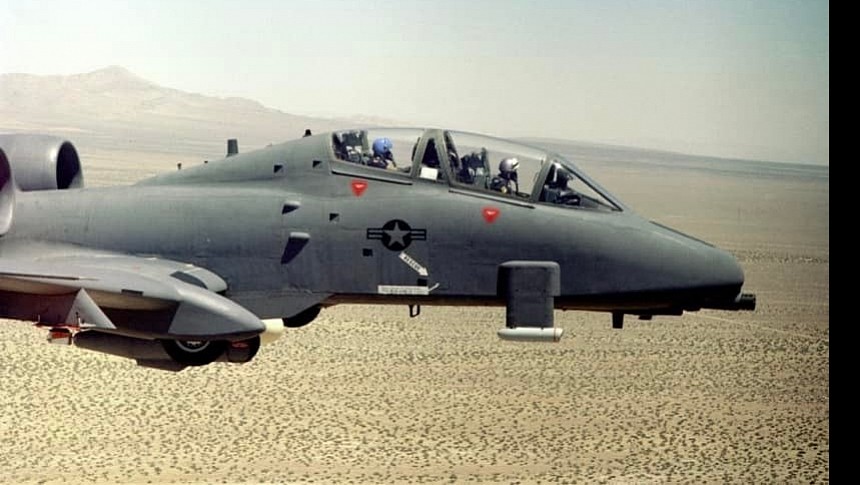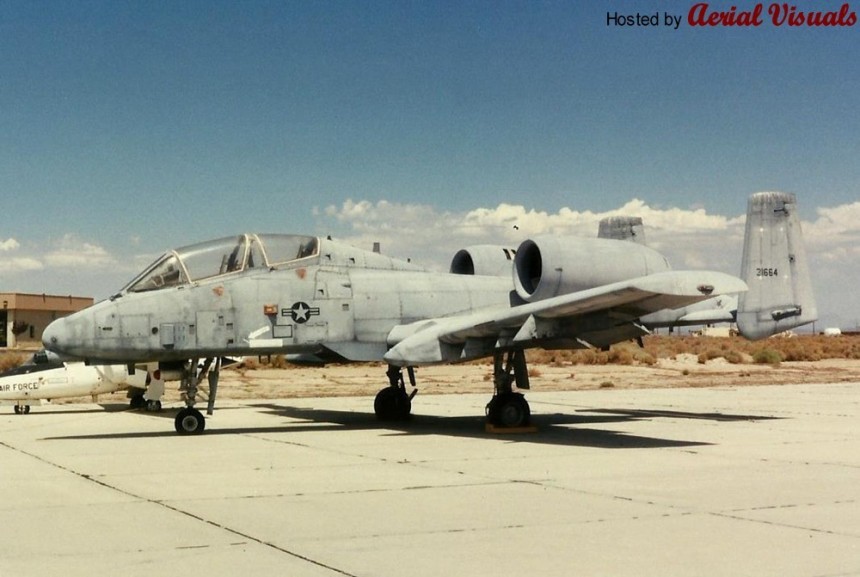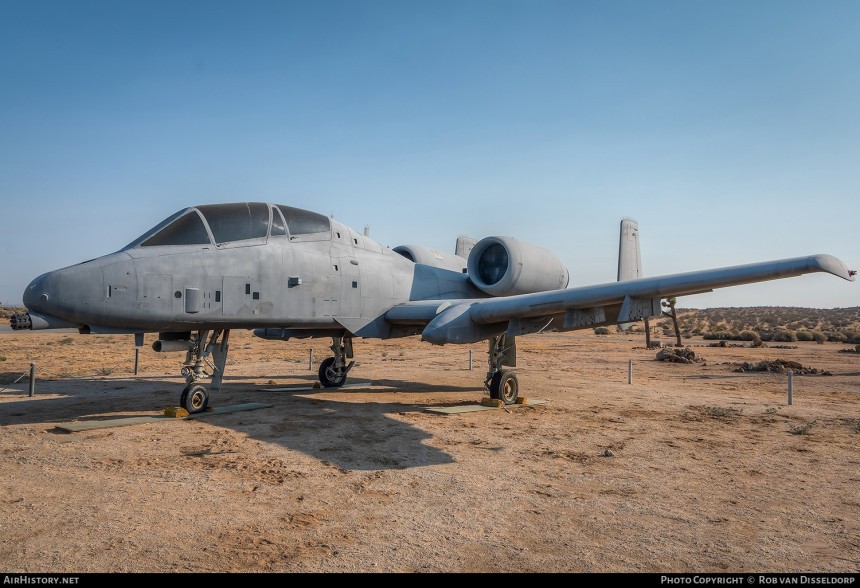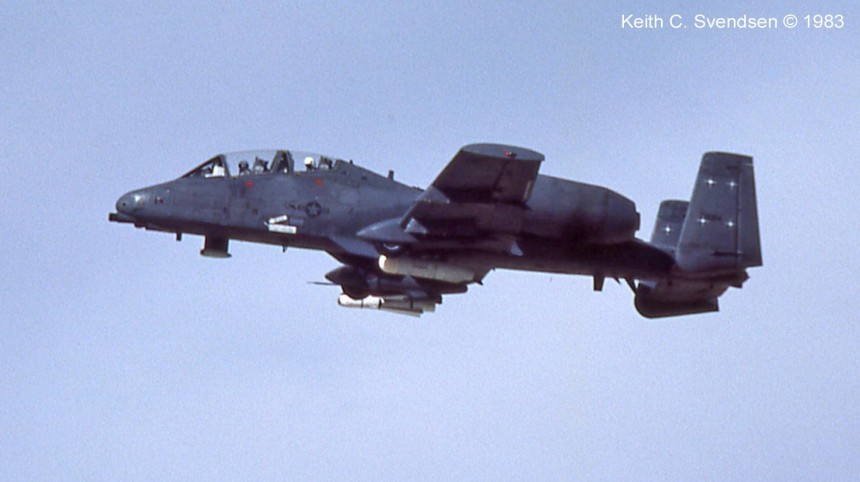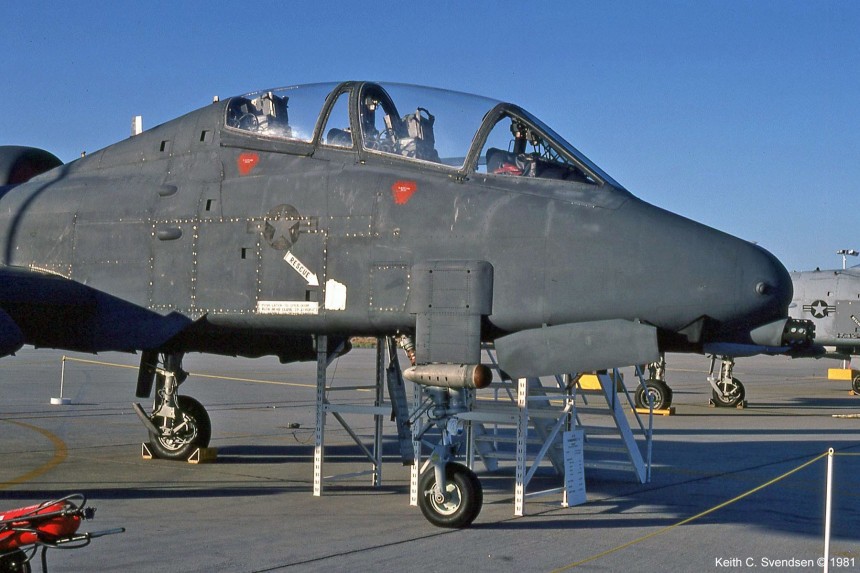In the early seventies, in the wake of the Vietnam defeat, the U.S. military realized the need for an effective close air support jet that could take a beating and deliver deadly blows without too much hassle. The Air Force had some formidable fighters, but they were mediocre or downright lousy at keeping a watch over ground troops from nearby, especially during the night or in a blinding storm. The Warthog stepped in, but it wasn’t the best tool for the job, so it was upgraded to meet specifications. That’s how the only twin-seat A-10 Thunderbolt II was born.
The A-10 Thunderbolt II is one tough fighter plane that likes to get up close and personal with its designated targets before fully (dis)integrating them into the surrounding environment. The single-seat flying cannon is one of the best antitank weapons in the U.S. military’s flying arsenal and gets the job done with cataclysmic accuracy. The plane is so simple and efficient that it takes only one pilot to operate. Imagine what it could be capable of if it had a second aviator in the cockpit.
Yes, the Fs have much more appeal and fame. Still, the Warthog is the tough-as-nails sun of a gun that can fly and fight below, above, and in the weather, thanks to its advanced avionics and superior weapons systems. However, there was a time when this iconic lone wolf tank buster almost morphed into a twin-seat archangel of the anytime, anywhere apocalypse.
The Air Force contemplated the possibility of an all-weather close air support attack jet operating equally in low-visibility weather or at night. Nowadays, that’s easily accomplished with high-tech equipment, but 50 years ago, it was up to the man in the cockpit to do the job. For one pilot to master all combat scenarios imaginable (or beyond the conceivable), it was nearly impossible. But with a duo of experienced airmen, the task is a whole different affair.
The Warthog is officially the A-10 Close Air Support aircraft, and the current variant of this flying antitank Gattling Gun is the A-10C. In 1976, the A-10A entered service and was upgraded to A-10C between 2005 and 2011. But what happened to B, one might ask? This isn’t one of those situations where C is B, and military logic dictates otherwise, but a more straightforward, albeit unsuccessful, attempt to make the A-10 platform even deadlier.
There was one A-10B, a single unit; the irony is that the ‘B’ was the first A-10A prototype. Nonsensical? Read on and see how this letter puzzle is solved. The roots of this apparent conundrum lie in the Vietnam War when the Air Force quickly discovered it lacked an airplane capable of adequately supporting ground troops.
The fighter jets of the time were great performers in their designated role but failed to provide critical firepower when the GIs doing the jungle fighting requested it. The only Close Air Support aircraft available was the single-propeller WWII-design Douglas A-1 Skyraider. A legacy of the Korean War, the plane fell victim to the technological leaps made in firearms development. The U.S. lost 266 A-1s during the war, mainly to Vietnamese small arms and not to antiaircraft weaponry.
That’s how the A-10 came to be. The rationale stood in line with the warfare ideologies of the era: the heavy fighting on land needs a more powerful arm up in the air, ready to strike at a moment’s notice. But technological breakthroughs aren’t a bullet-proof warranty (pun intented) against the age-old philosophy of war that says, ‘The general who is skilled in defense hides in the most secret recesses of the earth; he who is skilled in attack flashes forth from the topmost heights of heaven. Thus, on the one hand, we have the ability to protect ourselves; on the other, a victory that is complete.’
The art of war demands that every possible favorable situation be used at its maximum potential, and weather is a crucial factor on the battlefield. To defeat the enemy, one must first be able to fight anytime, anywhere, day or night, rain or shine. In the early days of jet aviation warfare, weather was a significant deterrent, with airplanes having limited capability to operate at night or in severe weather.
With fighter planes, two-airmen teams were the standard solution for acing both flying and fighting by Instrument Flight Rules (IFR) began growing in significance. With the pilot focused on keeping the plane in the air and raining hell over the enemy, the weapons systems officer could take care of the high-tech electronics.
Before technology became sophisticated enough to allow a fighter plane to fly in all weather and engage multiple targets simultaneously, air combat relied entirely on visual target acquisition. While it may sound brave and romantic, natural eyesight is limited to daytime and fair weather. When radar technology reached the compact size and high-reliability specs required to fit into an airplane, a dedicated operator was put in charge.
The initial application for this new paradigm was night warfare. Still, the setup was deemed compatible with flying in bad weather (as planes improved at braving all kinds of meteorological conditions). Putting an extra crew member and gear was paid in weight and space, resulting in lesser performance figures for the two-seat configurations than the original single-seat design.
However, fighting at night in bad weather is something that all armies worldwide have relied upon from the dawn of Man. A jet that could loiter over ground troops for extended periods in the harshest of conditions was the chef's kiss for the UASF in the early seventies. One that could be up at all times was the coupe de grace.
That was the logic behind the U.S. Air Force's decision to convert an A-10A single-seat to a two-seat air striker, designated A-10B. Its initial name was A-10N/AW (Night/Adverse Weather), and it was later rebadged with a single letter.
In March 1979, three years after the new plane was put into service, the first prototype of the famous Warthog was taken back to Fairchild Republic for a conversion. The modifications lasted roughly three months and involved rebuilding the forward airframe to add a second cockpit behind the original one. The canopy was redesigned from a clamshell type to a side-opening type, with thru-the-canopy ejection seats designed.
A cockpit fairing was mounted for the added avionics instruments and components, the Head-Up Display system was upgraded, and Forward Looking InfraRed (FLIR) and Low Light Level Television systems were installed. For its designated purpose of conducting night or bad-weather sorties, the A-10 prototype was fitted with laser ranging, terrain-following radar, a radar altimeter, an electronic moving map display, and an inertial navigation system.
External pods for the FLIR and laser ranger were mounted on the center fuselage station, while the terrain-following radar, also housed outside the fuselage, hung under the left wing. The vertical stabilizers were extended up by 20 inches (508 mm) extension. The signature feature of the A-10, the GAU-8/A 30-mm Gatling Gun, was left in place, but its ammunition drum capacity was reduced to 750 rounds from the standard 1,350.
A-10 N/AW (serial number 73-1664) began flight testing on October 23, 1979, at the Air Force Flight Test Center within Edwards Air Force Base in California. Over 48.6 flight hours, the plane flew 28 missions (one-third of them during the night). The test ended on December 4 that year, and the two-seat Thunderbolt II passed the exams. Unfortunately, it didn’t make it to series production since more sophisticated night attack weapons systems were deemed more suitable for the role.
In the early 80s, the one-off A-10A N/AW was redesignated the YA-10B, and on December 16, 1983, S/N 73-1664 was put in storage. It now resides at the Air Force Flight Test Museum on Edwards Air Force Base. Apart from this single unit, the USAF considered retrofitting a limited number of A-10As with a two-seat cockpit and using them as trainer aircraft.
The program was canceled before any plane could be modified, leaving us with just one example. Some aviators point out that numerous cases of blue-on-blues (friendly fire casualties) could have been prevented had the modified A-10B made it into production.
Yes, the Fs have much more appeal and fame. Still, the Warthog is the tough-as-nails sun of a gun that can fly and fight below, above, and in the weather, thanks to its advanced avionics and superior weapons systems. However, there was a time when this iconic lone wolf tank buster almost morphed into a twin-seat archangel of the anytime, anywhere apocalypse.
The Air Force contemplated the possibility of an all-weather close air support attack jet operating equally in low-visibility weather or at night. Nowadays, that’s easily accomplished with high-tech equipment, but 50 years ago, it was up to the man in the cockpit to do the job. For one pilot to master all combat scenarios imaginable (or beyond the conceivable), it was nearly impossible. But with a duo of experienced airmen, the task is a whole different affair.
There was one A-10B, a single unit; the irony is that the ‘B’ was the first A-10A prototype. Nonsensical? Read on and see how this letter puzzle is solved. The roots of this apparent conundrum lie in the Vietnam War when the Air Force quickly discovered it lacked an airplane capable of adequately supporting ground troops.
The fighter jets of the time were great performers in their designated role but failed to provide critical firepower when the GIs doing the jungle fighting requested it. The only Close Air Support aircraft available was the single-propeller WWII-design Douglas A-1 Skyraider. A legacy of the Korean War, the plane fell victim to the technological leaps made in firearms development. The U.S. lost 266 A-1s during the war, mainly to Vietnamese small arms and not to antiaircraft weaponry.
The art of war demands that every possible favorable situation be used at its maximum potential, and weather is a crucial factor on the battlefield. To defeat the enemy, one must first be able to fight anytime, anywhere, day or night, rain or shine. In the early days of jet aviation warfare, weather was a significant deterrent, with airplanes having limited capability to operate at night or in severe weather.
With fighter planes, two-airmen teams were the standard solution for acing both flying and fighting by Instrument Flight Rules (IFR) began growing in significance. With the pilot focused on keeping the plane in the air and raining hell over the enemy, the weapons systems officer could take care of the high-tech electronics.
The initial application for this new paradigm was night warfare. Still, the setup was deemed compatible with flying in bad weather (as planes improved at braving all kinds of meteorological conditions). Putting an extra crew member and gear was paid in weight and space, resulting in lesser performance figures for the two-seat configurations than the original single-seat design.
However, fighting at night in bad weather is something that all armies worldwide have relied upon from the dawn of Man. A jet that could loiter over ground troops for extended periods in the harshest of conditions was the chef's kiss for the UASF in the early seventies. One that could be up at all times was the coupe de grace.
In March 1979, three years after the new plane was put into service, the first prototype of the famous Warthog was taken back to Fairchild Republic for a conversion. The modifications lasted roughly three months and involved rebuilding the forward airframe to add a second cockpit behind the original one. The canopy was redesigned from a clamshell type to a side-opening type, with thru-the-canopy ejection seats designed.
A cockpit fairing was mounted for the added avionics instruments and components, the Head-Up Display system was upgraded, and Forward Looking InfraRed (FLIR) and Low Light Level Television systems were installed. For its designated purpose of conducting night or bad-weather sorties, the A-10 prototype was fitted with laser ranging, terrain-following radar, a radar altimeter, an electronic moving map display, and an inertial navigation system.
A-10 N/AW (serial number 73-1664) began flight testing on October 23, 1979, at the Air Force Flight Test Center within Edwards Air Force Base in California. Over 48.6 flight hours, the plane flew 28 missions (one-third of them during the night). The test ended on December 4 that year, and the two-seat Thunderbolt II passed the exams. Unfortunately, it didn’t make it to series production since more sophisticated night attack weapons systems were deemed more suitable for the role.
In the early 80s, the one-off A-10A N/AW was redesignated the YA-10B, and on December 16, 1983, S/N 73-1664 was put in storage. It now resides at the Air Force Flight Test Museum on Edwards Air Force Base. Apart from this single unit, the USAF considered retrofitting a limited number of A-10As with a two-seat cockpit and using them as trainer aircraft.
The program was canceled before any plane could be modified, leaving us with just one example. Some aviators point out that numerous cases of blue-on-blues (friendly fire casualties) could have been prevented had the modified A-10B made it into production.
